How Are Diamonds Made? Natural vs Lab-Created Explained
Two Paths, One Diamond Not all diamonds come from the same place — but they all start the same way. Pure carbon, crystalized under immense pressure and heat. Whether it…
For nearly 30 years JCK Las Vegas has been a lodestone event for the diamond, gem, and jewelry trade, connecting suppliers from around the globe with front-line retailers during slow summers, in anticipation of the prosperous holiday season.
After a pandemic-related year off JCK Las Vegas resumed with a show at the end of August 2021. Staged later than usual, with predictably lower turnout, it was considered a successful event nevertheless, with participants widely expressing satisfaction at the amount of business conducted and connections made.
Martin Rapaport
Martin Rapaport’s “State Of The Diamond Industry” Sunday breakfast is one of JCK’s best attended events. That trend continued in 2021 with a full ballroom at the Venetian Resort and hundreds watching via live stream. Martin, best known for publishing a monthly list of B2B trading prices for diamonds, owns the Rapaport Group, a network engaged in industry news-reporting, diamond auctions and trading, recycling, and grading services.

Martin is not just an analyst he is an accomplished entertainer. The perspective he provides is made effective and memorable due to the manner in which it’s provided. That isn’t to say everyone agrees with his opinions or advice. Many decidedly do not. And while this year’s breakfast was cool, calm, and copasetic – free of any angry shouts, outbursts, or heated accusations from audience members – the potential for a breakout brouhaha at this annual presentation is ever-present, which probably doesn’t hurt attendance.
Breakfast popcorn, anyone?
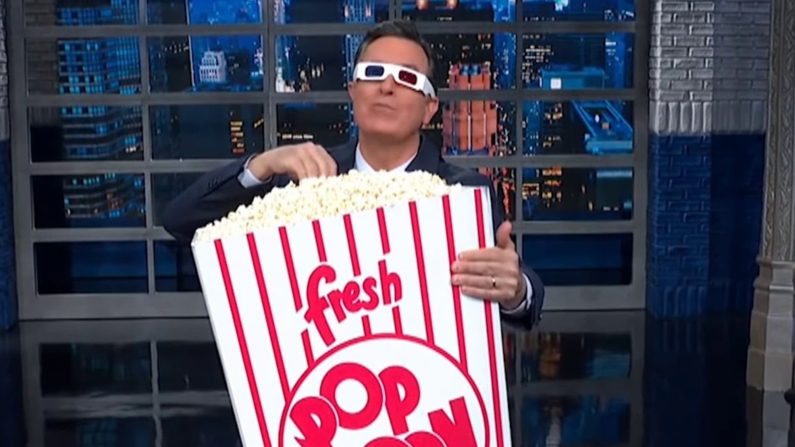
2021 State Of The Diamond Industry
During Martin’s welcome, he asked the audience how a diamond is created. The answer came quickly, “you cut it with another diamond.” Indeed. As diamond polishes diamond, Martin continued, diamond dealers work with each other. When dealers come together and share knowledge it creates something special. Dealers need to come together and it’s good to be back here working together.
This positive welcoming sentiment was followed with somber Covid statistics, recognition of what humanity has endured during the pandemic, and a long moment of silence in memory of those lost to the pandemic.
Martin discussed how continuous change in the world is fostering ongoing uncertainty. Factors such as Covid, severe weather events, and supply shortages continue to create both short term and long term uncertainties across the board. Martin asked how these things are combining to change peoples’ attitudes in different ways. For example, have people who lost their houses to wildfires in California changed their attitudes about global warming and how the products they buy influence the environment?
“How we live has changed. It’s all confusing and it’s still changing.” – Martin Rapaport
The foundation of Martin’s 2020 State Of The Diamond Industry Webinar was the combination of physical, social, financial, and emotional considerations which combine to influence society’s collective moods, attitudes, and philosophies. He recapped this again, as it continues to be germane.
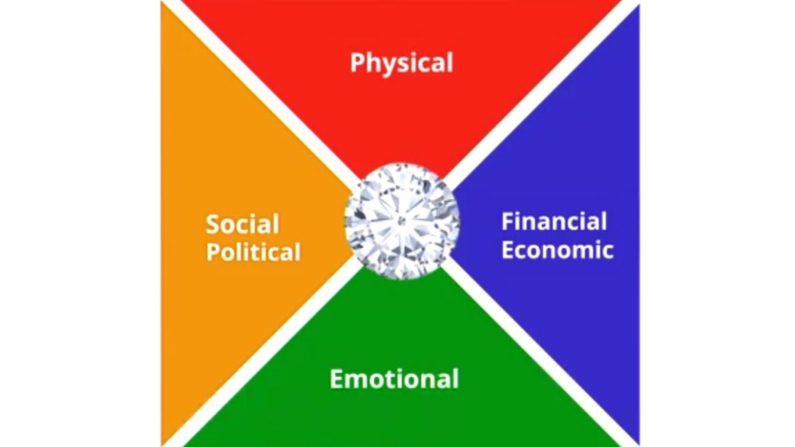
Martin stated that the diamond and jewelry industry continues to undergo continuous change. Some of those changes are due to Covid. Some are due to other factors. He believes the biggest issues we face in the industry today are Covid, digitalization, disintermediation, and social responsibility.
Digitalization
Before giving his opinion on what retailers must do to improve in terms of digitalization Martin showcased an example of a jeweler that turned crisis into opportunity.
Signet Jewelers, parent company to Kay’s, Jared, JamesAllen.com, and others, is the world’s largest jewelry retailer. As the world went into lockdown many industry entities endured a huge drop in value, including Signet. However, this was followed by a tremendous increase over the course of the pandemic, which ultimately increased the company’s value 10-fold.
Gina Drosis, CEO of Signet, pre-recorded a message for Martin’s event, sharing the steps they took to survive and even thrive in unprecedented times.

In response to the crisis, Signet temporarily closed 2,800 stores across the United States, Canada, and the United Kingdom. According to Gina, lockdown made that decision easy, but it was hard going into uncharted territory. In terms of the next steps, she shared three lessons learned.
First lesson: Through any crisis, maintain focus and purpose. Be sure your team members take pride in what you’re doing, she said. While working through the crisis Signet publicly announced 44 sustainability goals aimed at improving the world. Additionally, all their suppliers will be RJC certified by 2025. In terms of generating internal pride, responsible business practices are key.
Second lesson: The power of data. Gina said that the numbers and analytics they have mined during the pandemic prove how important love is, and how customers are expressing that love even more. Their research shows that safety is still a chief concern. As of July 2021, she reported that Signet customers have high concerns about the Delta variant of Covid but those who shopped less during the pandemic are excited about returning to in-person shopping, which informs business decisions.
Third lesson: Consumers value convenience more than they did pre-Covid. Gina said that doing things to bring your business closer to your customers, especially when they can’t come to you, is key.
I have my own observation about Ms. Drosis’ third lesson. She did not spend time making a connection between “convenience” and “e-commerce.” This is logical, considering that Rapaport’s audience is primarily brick & mortar retailers, but I would note that her company made a herculean digital pivot in 2020. Their e-commerce sales rose a staggering 61%, year over year, primarily due to their new “Path to Brilliance” program offering digital solutions for shoppers. That suite of services included virtual appointments, access to experts, online events, and improved website experiences. They supplemented these things on the backside by launching new delivery initiatives, product shipping, and “BOPIS” (Buy Online Pickup In-Store). This focus on “digital convenience” paid off, increasing Signet’s fulfillment capacity by 500% in tandem with distribution partners who successfully delivered >98% of their North American customer orders on time. The result? In January 2021, Signet’s stock jumped more than 6% after reporting their same store sales from November 1, 2020 – January 2, 2021, were up 5.6% when compared to pre-pandemic 2019.
Returning to the Rapaport event: Gina closed by stating that “a crisis is a terrible thing to waste.” Specifically, when Signet was forced to shut physical locations down, they leaned in on their mission and sped things up in other channels.
“Pressure makes diamonds. Turn the crisis into a positive opportunity.” – Gina Drosis
Disintermediation
Digitalization and social responsibility have been Rapaport breakfast menu items for several years. In 2021 they were joined by a side of disintermediation.
Disintermediation is an economics term which refers to the reduction of intermediaries between producers and consumers. In Martin’s words “Disintermediation is businesses that can’t adapt getting replaced. Going out of business. Bigger companies buying smaller companies.”
Martin cautioned jewelry businesses to avoid disintermediation by distinguishing themselves and clearly defining their unique selling proposition. “How are you adding value to your customers?”
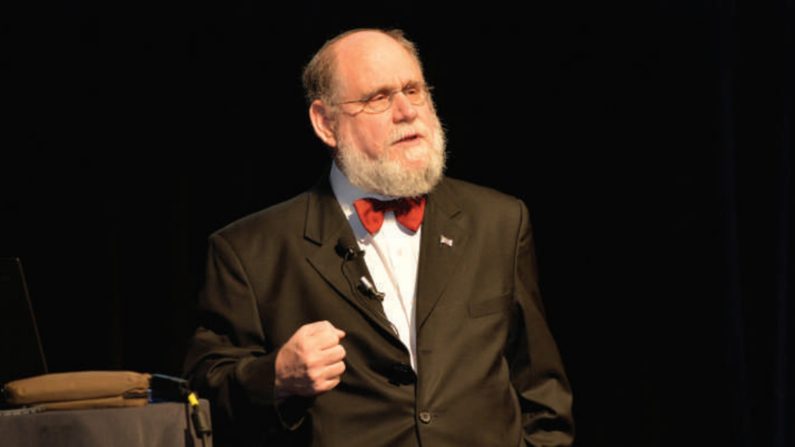
In the new normal, according to Martin, these two things are connected. It’s no longer just about what you sell but how you adopt digitalization. What’s your digital marketing strategy? What are you selling? How are you communicating? If people don’t see you on the internet, they won’t buy the product – he said – so if you don’t have an internet presence, you’re in big trouble.
Technology has become a key component for jewelry sales, driven by the fact that Covid demands it. The whole way in which people think about looking online, shopping online, buying online has changed. Martin said Covid has pushed people toward digital buying. “Data and digitalization are coming at us in ways we couldn’t imagine years ago.”
He asked: Do you have virtual diamonds and jewelry? Are you on different social channels? Do you integrate business and social? Do you have multi-level customer communication and acquisition? How are you drip campaigning and nurturing? How are you following up?
The key to success with “digital jewelry” will be combining high diamond & jewelry expertise with high technological expertise. That is what will be most potent in communicating value effectively.
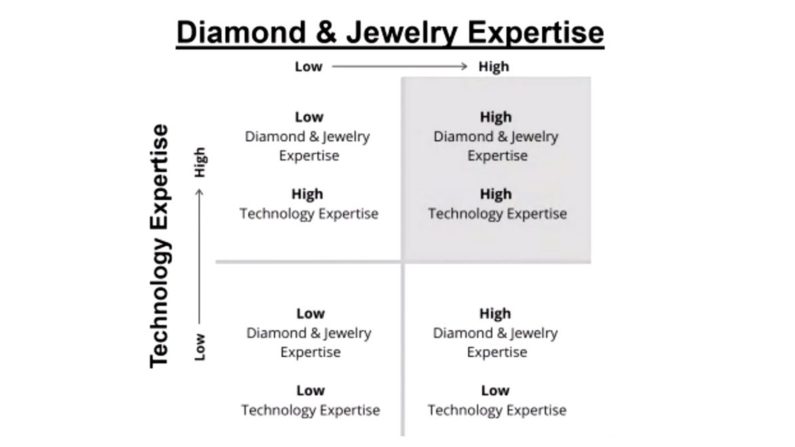
For retail jewelers, there is a technical challenge to all of this. As Martin observed, “Costco, Amazon and eBay are better at technology than you are, but they’re terrible at selling jewelry. Your opportunity, therefore, is value.”
“Home shopping & television didn’t kill us. Amazon didn’t kill us. eBay didn’t kill us. The people who do this right will inherit the diamond, gemstone and jewelry business.” – Martin Rapaport
Martin urged the audience to add value when leveraging technology. Your business must be built upon you, your personality, your ethics, and your values, he said. It’s not just about storing the information, it’s about digitizing and transacting those things online. People on Instagram are merging their products with their personalities and their personal experiences. “Maybe this will replace the shopping mall?” he speculated.

Martin asked the audience: What are you doing that’s different? What are you doing that’s stopping your customers from going around you to your suppliers? What is the value of your personalization? We need to question how we are adding value, and if it isn’t with human interaction, get ready for disintermediation.
“A diamond travels the world. From Africa to Belgium to India to New York to Atlanta Georgia. What’s happening over the last 18 inches from you to your customer?” – Martin Rapaport
The good news, for those who adapt, is the stage is set for success.
Upward Trending Sales
Each year Martin presents a series of slides covering the past year’s global movement of diamonds and jewelry. This portion of the presentation is made knowing he has a worldwide audience, so he spends considerable time breaking down rough diamond, polished diamond and jewelry exports and imports region by region, globally. This year focused on changes from both 2019-2020 and 2020-2021.
For purposes of this review, the takeaway is that – while 2020 was a difficult year for sales and remains difficult for the industry’s vital hubs in India – the stage is ultimately being set for a roaring comeback.
Imports and exports of diamonds through India over 1H 2021 were nearly that of total output from FY 2020. This is happening despite recurring on-again, off-again Covid stoppages which are hindering India’s migrant polishing workforce. Despite the surge, supply is not keeping up with demand.
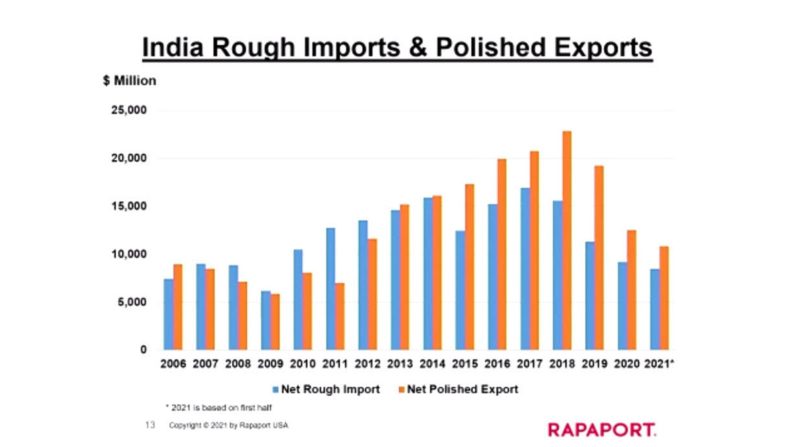
This can be correlated with surging natural diamond prices – which were up 26.3% at the end of August 2021, compared to their low point in 2020.
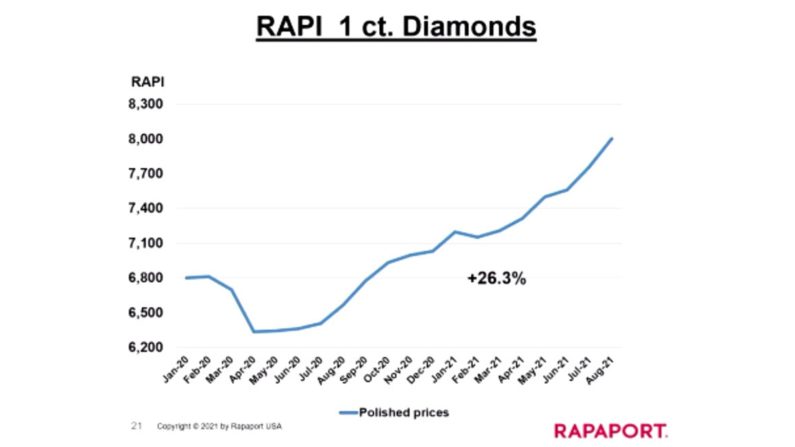
On the world stage, the steady demand seen in the USA is reflected in the Chinese marketplace. According to Rapaport, Chao Tai Fook is up 70% year on year for the quarter ending June 20, 2021. They are also buying high colors and clarities, Martin said, which means – if you’re an Indian diamond seller – you have two heavily competing markets and can sell to whichever pays more.
Domestically, Signet may have been showcased by Martin but they are not the only jeweler enjoying strong sales in 2021. I’d note that, for the quarter ending June 30, luxury group Richemont reported a 129% increase over 2020, and 43% compared to 2019, primarily attributed to sales at their jewelry Maisons. On the whole, Mastercard reported that U.S. Jewelry sales were up 82.6% in July, compared to July 2020, and 54.2% compared to 2019. These upwards trends started last summer and have been seen across the board, from chain stores to luxury brands.
Social Responsibility
The Rapaport Group held a separate three-hour conference on social responsibility Sunday afternoon. There is much to unpack on this topic and that’s a good thing: In the coming months, I will be sharing more on PriceScope, globally, regarding this vital area of human consciousness.
Martin said that when you adopt social responsibility, you make changes. Those changes can take many different forms. Do you stop accepting cash? Do you get everyone iPads? Do you buy carbon offsets? Do you switch to a cloud-based security system? Do you seek carbon-neutral couriers? What are you going to do to join this movement? You can give to charity. You can support the local little league club. Whatever it means, he said, product-centric social responsibility and supply chain social responsibility are going to become the norm.
Martin’s second guest-video featured Farai Maguwu, founding director of the Centre for Natural Resource Governance (CNRG), an organization working on improved governance of natural resources in Zimbabwe. Farai has been engaging with officials to try and understand how diamonds are being managed in that troubled country.

Technically, Zimbabwe’s diamonds are not considered conflict diamonds because the Kimberley Process defines conflict stones as rough that rebel movements use to finance wars against legitimate governments. Unfortunately, a byzantine set of circumstances and generational oppression by Zimbabwe’s “legitimate government” continues to plague artisanal miners in the Marange diamond fields.
Since the 1990s the diamond industry has acted in concert with the United Nations, the governments of nearly 100 nations, NGOs, and environmental groups toward improving human and environmental stewardship where natural diamonds are found. Arguably, no industry has done more to improve conditions upstream than the natural diamond industry. Unfortunately, rogue situations like the one in Zimbabwe persist.
Farai’s report (you can read a summary here) was a heartbreaking reminder that conflict minerals like tin, tungsten, gold, and coltan – a component in mobile devices – continue to fuel human rights violations today and, in the case of Zimbabwe, impacts diamond mining there.
In the case of Zimbabwe today, or Venezuela, the DRC, and others in the past, Western trading centers impose an embargo on rough from those countries. Nevertheless, while Zimbabwe’s Marange fields only produce a tiny fraction of global rough output, it’s getting purchased somewhere, potentially China or India, belying the notion that all diamonds sold in jewelry stores can be guaranteed “conflict free.”
To that end, directly related to Farai’s report, Edward Asscher, president of the World Diamond Council (WDC) has issued a challenge to the industry to redefine/expand the definition of “Conflict Diamond.”
“Unless that is expanded, it cannot be expected to be a panacea to other challenges afflicting artisanal miners, including human and labor rights violations, bribery, and corruption.” – Edward Asscher
Martin concluded with the United Nations Sustainable Development Goals: A call for action by all countries – poor, rich, and middle-income – to promote prosperity while protecting the planet. According to the U.N., ending poverty must go hand-in-hand with strategies to build economic growth and address a range of social needs including education, health, social protection, and job opportunities, while tackling climate change and environmental protection.
In addition to being in-step with social responsibility consciousness, these goals provide a critical framework for COVID-19 recovery.
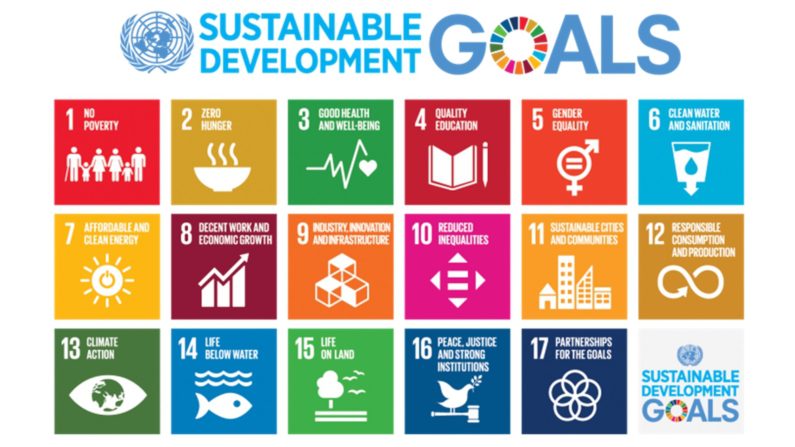
Summary
“We’re not out of Covid but we’re out of the wave of change Covid caused to the diamond industry.” – Martin Rapaport
Martin concluded with a reminder that, although the tidal wave Covid created may be subsiding, we’re going to be experiencing further, residual waves of change that we didn’t create. We are all surfing. Waves are hitting us. The key to survival is learning to surf the waves of change, not stand in their way.
Our industry will be sustained because diamonds and jewelry represent enduring value. People are looking for relationships. Now more than ever, the values implemented by Covid have changed how people think about each other, which plays directly into how and where they want to buy jewelry. Meaningful gifting is part of having a relationship. Relationships are more important now than ever.
When you give a person a diamond it’s physical security, Martin said. She isn’t going to eat it or spend it. It’s there. It’s not just physical security, it’s also emotional security. When you bind an engagement ring with a valuable diamond and it becomes hers you are sharing physical and emotional security, which is what people are looking for.
They’re looking for it today. They’ll be looking for it tomorrow.
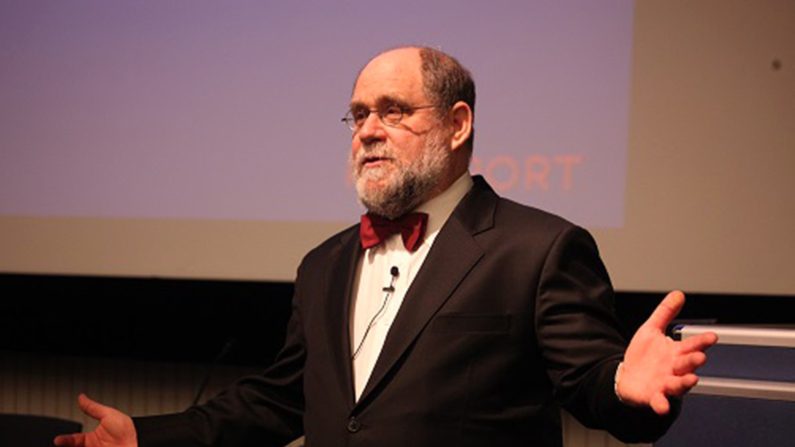
Watch The Rapaport Breakfast at JCK 2021 on Rapaport.com.
Written by John Pollard
How has Covid changed your mood? Has it changed your attitide? Have your shopping habits changed? Are you purchasing more or less luxury items? What role do you think the diamond industry should play in terms of social responsibility? In terms of human stewardship? In terms of animal and environmental stewardship? What can be done to combat geopolitical situations where human rights violations persist, beyond industry embargos?
Learn how to define brightness, leakage, contrast, and scintillation on our page Diamond Performance Explained.
Take your diamonds on a brightness, fire, and sparkle test drive: Make Comparisons Like an Expert.
Get fast answers to any question: Ask our community of unbiased independent helpers.
Ready to find your diamond?